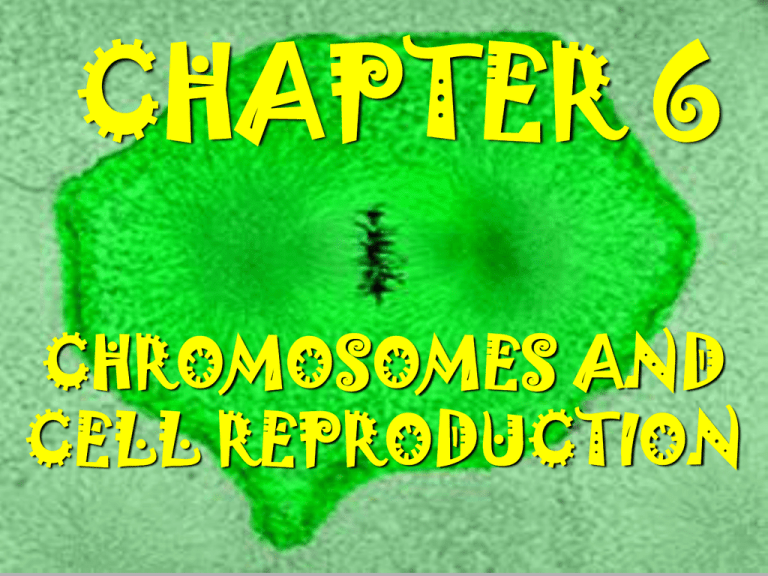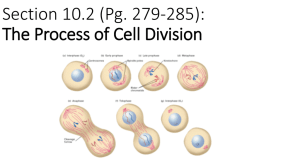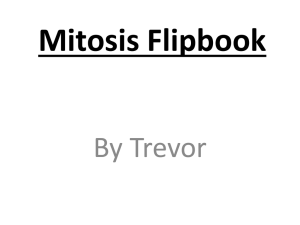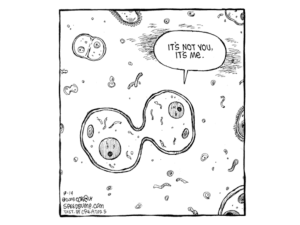
CHAPTER 6
CHROMOSOMES AND
CELL REPRODUCTION
I. CHROMOSOMES
A.
Formation of New Cells
1. Prokaryotic Cells
-Reproduce by BINARY FISSION
-Create a genetic duplicate
2. Eukaryotic Cells
-In a resting cell, DNA exists as
thin, uncoiled strands known as
CHROMATIN, and can be found
in the Nucleus of the cell.
-During cell division the DNA
will REPLICATE and begin to
coil around special proteins
called HISTONES
-The DNA/HISTONE structure is
together referred to as a
CHROMATID
-CHROMOSOMES consist of
two chromatids or SISTER
CHROMATIDS, that join
together.
-The parts, original and copy
are attached by a
CENTROMERE
DNA
When a molecule of DNA is being
used to direct a cell’s activities,
areas containing specific active
genes are extended.
II CHROMOSOME NUMBERS
A. Sets of Chromosomes
- Every species has a characteristic
number of chromosomes in each body
or somatic cell
- Numbers vary among species:
Humans = 46 or 23 pairs
- Homologous Chromosomes-
Chromosomes that are similar in size, shape and genetic
contents.
They are pairs of chromosomes containing genes that
code for the same traits.
- Cells that contain both
chromosomes of a homologous
pair are said to be DIPLOID (2n)
these are somatic or body cells
- Cells with one chromosome of a
pair HAPLOID (n) these are
gametes or sex cells.
B. Sex Chromosomes
-These are the chromosomes that
determine the sex of an individual.
(1 pair)
-All
other chromosomes are
referred to as AUTOSOMES (22 pair)
-Sex chromosomes are labeled X , Y
-In humans XX is female
XY is male
C. Changes in Chromosome Number
-Sometimes, due to various reasons,
the number of chromosomes is
altered.
-Chromosome number can be
checked using a number of
methods…
Chorion villi Sample
Amniocentesis
Karyotype
Prenatal-Testing
Karyotype- is how chromosomes are checked.
•Of the 23 pairs of chromosomes in human somatic
cells, 22 pairs are called autosomes.
•One of the 23 pairs are involved in determining the
sex(gender) of an individual. Also known as sex
chromosomes.
III. THE CELL CYCLE
-Defined as a repeating sequence of
cellular growth and division during
an organisms life.
A. The five phases of the cell cycle…
First Growth (G1)
Together
known as
Synthesis (S)
Second Growth (G2) INTERPHASELongest phase
Mitosis
of the cycle
Cytokinesis
4 min
G1(first growth)- Cell grows and carries
out normal functions. Cells that do not
divide stay in this phase.
S phase:(synthesis)- DNA replicates and
chromosomes
are made.
G2:(second growth)- Final preparations for
division are
made
Mitsosis- Division of the chromosomes
into two separate, equal numbered
sides
Cytokinesis- Cytoplasm divides
B. Control of the Cell Cycle
-Cell cycle has key “checkpoints” that can
trigger or delay the following phases.
-Checkpoints are controlled by enzymes.
G1 Checkpoint- decides if cell will divide
G2 Checkpoint- allows for the checking of
DNA and proceeds to mitosis
Mitosis Checkpoint- signals end of mitosis
and the start of G1 phase.
Cell size is the main factor that leads to cell
division.
C. Steps of Mitosis- PMAT
Broken
into four stages
1) PROPHASE:
-The nuclear membrane and the
nucleolus begins to breakdown
-In animal cells the centrioles
develop and move away from
each other
-SPINDLE FIBERS,
strands of protein
connect the
chromosomes and
the centrioles.
- A spindle fiber is a
specialized form of
microtubule.
1 min
http://bio.rutgers.edu/~gb101/lab2_mito
sis/graphics/aavideo.mov
2) METAPHASE:
-Centrioles reach
the opposite ends of
the cell
- The fibers move the
chromosomes to the
center (equator) of
the cell.
-The chromosomes
are now lined up.
30 sec
3) ANAPHASE:
-The sister chromatids
that make up the
chromosomes are
pulled apart at the
centromeres by the
fibers.
-The spindle fibers pull
each chromatid strand
toward the centrioles
at opposite ends of the
cell.
4) TELOPHASE:
-Each end of the cell now has a
complete set of chromosomes.
-Chromatids unwind and
return to DNA strands –
Chromatin
-Nucleus and Nucleolus
reform
-The spindle
fibers/centrioles
disappear
-The nuclear
membrane begins to
reform
-The nucleolus
reforms
D. CYTOKINESIS: Begins when
mitosis ends.
-Cytoplasm is divided in half between
the two new daughter cells
-Animal cells: form a protein belt
that creates a “cleavage furrow”
-Plant cells: create a “cell plate” that
becomes the new cell wall
Cleavage furrow
Cell plate
END RESULTS
-Two new cells
-smaller in size than the original
-same # of chromosomes










